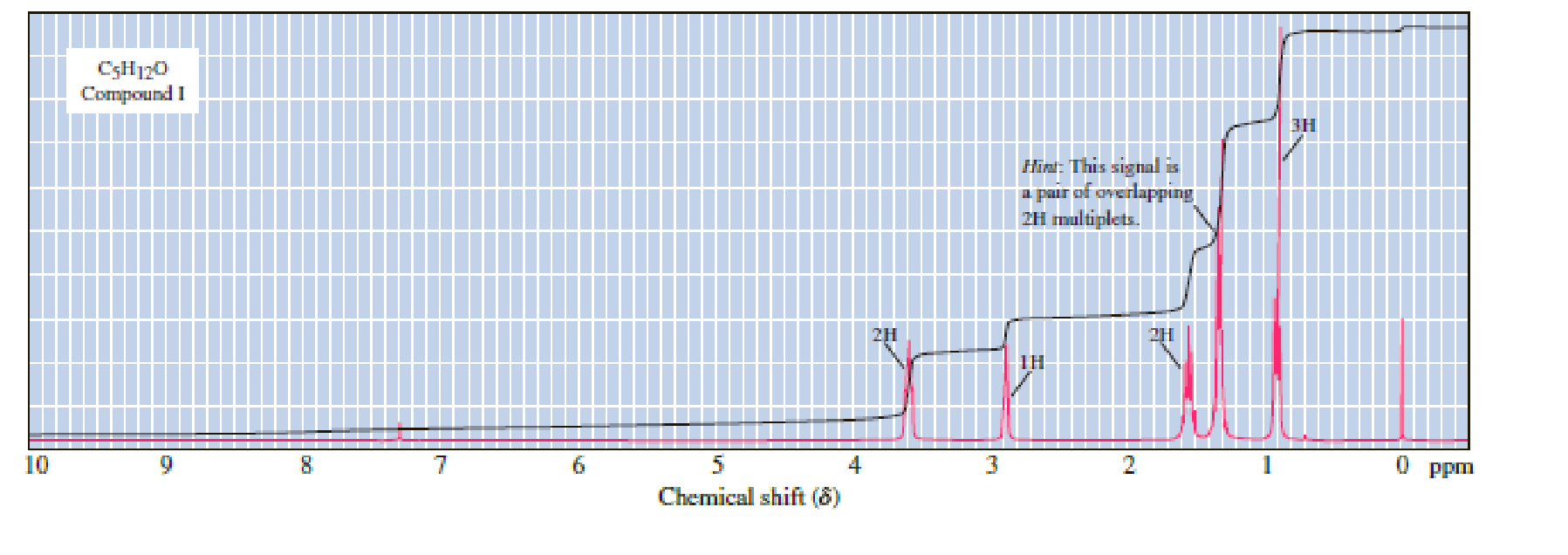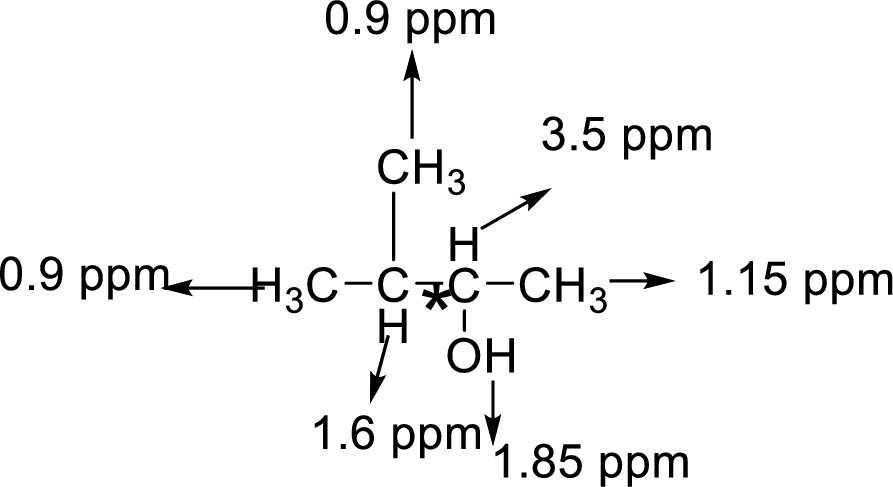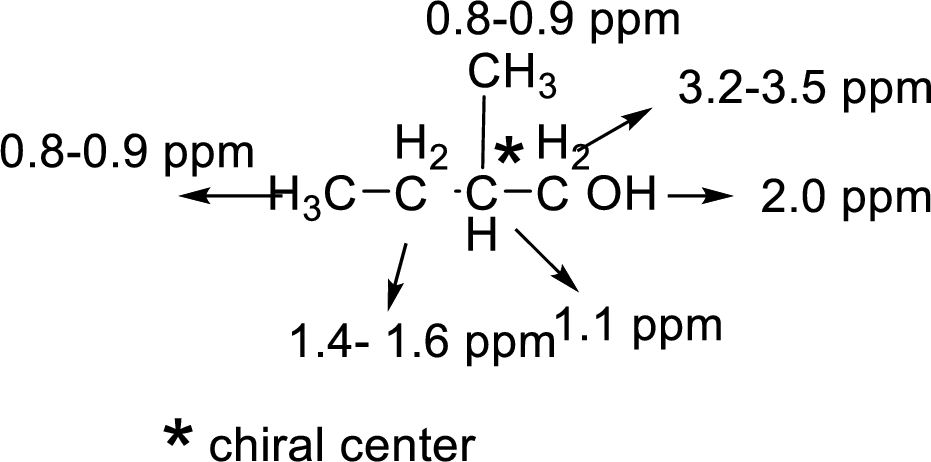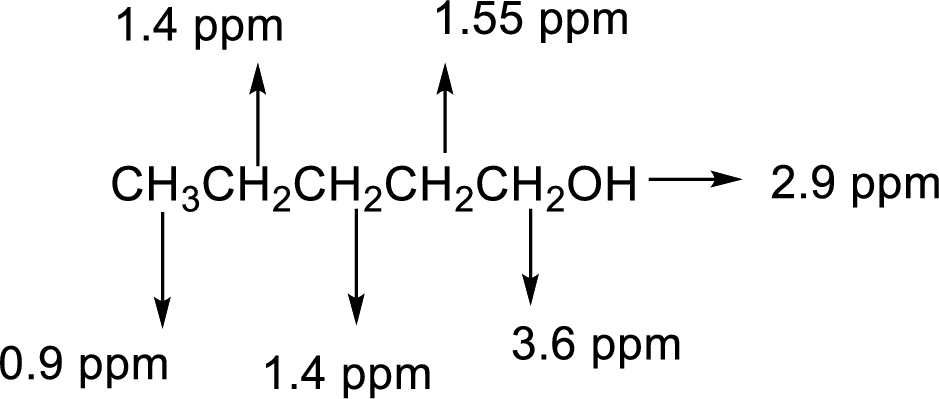
Concept explainers
Following are 1H-NMR spectra for compounds G, H, and I, each with the molecular formula C5H12O. Each is a liquid at room temperature, is slightly soluble in water, and reacts with sodium metal with the evolution of a gas.
(a) Propose structural formulas of compounds G, H, and I.
(b) Explain why there are four lines between δ 0.86 and 0.90 for compound G.
(c) Explain why the 2H multiplets at δ 1.5 and 3.5 for compound H are so complex.



(a)
Interpretation:
Following compounds G,H and I stractural formula has to be proposed with the help of given molecular formula
Concept introduction:
The
Chemical shift: The NMR spectrum of any compound is taken with reference to a standard compound called reference compound. Generally, tetramethylsilane (TMS) is taken as the reference compound. The methyl protons of TMS are equivalent and produces only one sharp peak at the rightmost end of the scale.
The distance between the TMS signal and the signals produced by the compound is called the chemical shift. Chemical shift basically measures the shift in the signal position of the compound with respect to the reference signal.
Chemical shift in delta scale is given as,
Explanation of Solution
Index of Hydrogen Deficiency (IHD) calculation,
Given molecular formula is
We calculate the
From the molecular formula, there is an index of hydrogen deficiency is zero for these molecules, so there are no rings (or) double bonds.
The fact that the compounds are slightly soluble in water and react with sodium metal indicates that each molecule has an hydroxyl
The
There are 5 peaks observed in the given
A multiplet is observed for 1 hydrogen at around
The one doublet is observed for 1 hydrogen at around
Another one multiplet is observed for one hydrogen at around
One doublet is observed for 3 hydrogens at around
The one doublet is observed for 6 hydrogens at around
Based on the above

The
There are 5 peaks observed in the given

The
There are 5 peaks observed in the given
Based on the above

(b)
Interpretation:
The following compound-G has four lines observed in the range of
Concept introduction:
The
Diastereotopic: If the protons are not interchangeable by either of the symmetry operations, then the protons are Diastereotopic; the protons are not chemically equivalent if a chiral center present in the molecule.
Explanation of Solution
Let us consider the given compound-G:

Above the molecule, the carbon atom 2 attached with hydroxyl
That is makes the two methyl groups are diastereotopic, so they have different chemical shifts, the four lines are actually two doublets.
(c)
Interpretation:
The Following compound-H is two hydrogens appread at multiplet, this compound is complex or not, the behaind reason should be explained.
Concept introduction:
The
Chemical shift: The NMR spectrum of any compound is taken with reference to a standard compound called reference compound. Generally, tetramethylsilane (TMS) is taken as the reference compound. The methyl protons of TMS are equivalent and produces only one sharp peak at the rightmost end of the scale.
The distance between the TMS signal and the signals produced by the compound is called the chemical shift. Chemical shift basically measures the shift in the signal position of the compound with respect to the reference signal.
Chemical shift in delta scale is given as,
Diastereotopic: If the protons are not interchangeable by either of the symmetry operations, then the protons are Diastereotopic; the protons are not chemically equivalent if a chiral center present in the molecule.
Explanation of Solution
Let us consider the given compound-H:

Above the molecule, the carbon atom 2 attached with hydroxyl
This chiral center makes the adjacent
Want to see more full solutions like this?
Chapter 13 Solutions
ORG.CHEM:TXT+OWLV2+MINDTAP 6MTHS >BI<
Additional Science Textbook Solutions
Living by Chemistry
General, Organic, and Biological Chemistry - 4th edition
Chemistry: The Central Science (13th Edition)
Chemistry: Structure and Properties (2nd Edition)
- Propose a structural formula for the analgesic phenacetin, molecular formula C10H13NO2, based on its 1H-NMR spectrum.arrow_forwardKetones undergo a reduction when treated with sodium borohydride, NaBH4. What is the structure of the compound produced by reaction of 2-butanone with NaBH4 if it has an IR absorption at 3400 cm-1 and M+=74 in the mass spectrum?arrow_forwardHow could 1H NMR spectroscopy be used to distinguish among isomersA, B, and C?arrow_forward
- There are several isomeric alcohols and ethers of molecular formula C5H12O. Two of these exhibit the following 1H-NMR spectra. Propose a structure for each of the isomers. Isomer A: δ = 0.92 (t, 7.8 Hz, 3 H), 1.20 (s, 6H), 1.49 (q, 7.8 Hz, 2H), 1.85 (s, 1H) ppm Isomer B: δ = 1.19 (s, 9 H), 3.21 (s, 3H) ppmarrow_forwardAn aromatic compound K, whose molecular formula is C8H11N, is examined in the laboratory to elucidate its structure. The following observations were made: A) Compound K is soluble in dilute hydrochloric acid but insoluble in sodium hydroxide solution. B) Treatment of compound K with excess potassium hydroxide and benzenesulfonyl chloride, C(6)H(5)SO(2)Cl, results in the formation of a heterogeneous mixture. The NMR spectrum of compound K is shown below. C) Compound K when treated with acetic anhydride[CH3-C(O)-O-C(O)-CH3], gives compound L, whose molecular formula is C(10)H(13)ON. Compound L is insoluble in dilute acid or dilute base at room temperature, heating compound L in dilute acid or base, however, regenerates compound K. D) When compound L is heated with a mixture of concentrated nitric acid and sulfuric acid, a single product, compound M, with the molecular formula C(10)H(12)O(3)N(2) is formed in excellent yields. On the basis of these observations draw the structures of…arrow_forwardCompound 2 has molecular formula C6H12. It shows three signals in the 1H-NMR spectrum, one at 0.96 ppm, one at 2.03 ppm, and one at 5.33 ppm. The relative integrals of these three signals are 3, 2, and 1, respectively. Provide structure for compound 2, explain how you reached your conclusion.arrow_forward
- Draw the structure of a compound with the formula C5H10O2 (along with the reasons of choosing it) which, upon analysis, gave key peaks in an infrared spectrum at 3450 cm-1 and 1713 cm-1, as well as the following 1H-NMR spectrum.arrow_forwardFrom the following 1H-NMR and 13C-NMR spectra, assign a structure for a compound with a formula of C4H9Br:arrow_forwardAnalyse the high resolution proton NMR spectrum of a compound with a molecular formula of C8H16O2 and and write its name. Options: A. 2-ethylhexanoic acid B. 1,4-cyclohexanedimethanol C. ethyl hexanoate D. butyl butyrate E. ethyl 2,2-dimethylpropanoatearrow_forward
- (a) Compound A has molecular formula C5H10O. It shows three signals in the 1H-NMR spectrum - a doublet of integral 6 at 1.1 ppm, a singlet of integral 3 at 2.14 ppm, and a quintet of integral 1 at 2.58 ppm. Suggest a structure for A and explain your reasoning. (b) Compound B has molecular formula C8H6O2. The IR, 1H-NMR, and 13C-NMR spectra are shown below, they are also downloadable for closer inspection by clicking the link under the spectral data. Suggest a structure for B and explain your reasoning. (c) Compound C has molecular formula C5H8O. The IR, mass, 1H-NMR, and 13C-NMR spectra are shown below, they are also downloadable for closer inspection by clicking the link under the spectral data. Suggest a structure for C and explain your reasoning.arrow_forwardWhen a compound with molecular formula C11H14O2 undergoes acid-catalyzed hydrolysis, one of the products that is isolated gives the following 1H NMR spectrum. Identify the compound.arrow_forwardPhenacetin is an analgesic compound having molecular formula C10H13NO2. Once a common component in over-the-counter pain relievers such as APC (aspirin, phenacetin, caffeine), phenacetin is no longer used because of its liver toxicity. Deduce the structure of phenacetin from its 1H NMR and IR spectra.arrow_forward
 Organic ChemistryChemistryISBN:9781305580350Author:William H. Brown, Brent L. Iverson, Eric Anslyn, Christopher S. FootePublisher:Cengage Learning
Organic ChemistryChemistryISBN:9781305580350Author:William H. Brown, Brent L. Iverson, Eric Anslyn, Christopher S. FootePublisher:Cengage Learning

